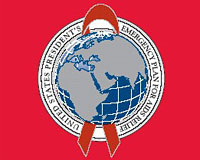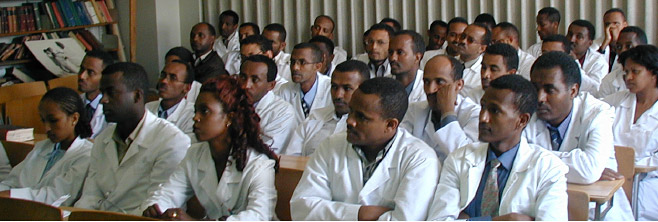| Tuberculosis and HIV/AIDS (Updated August 2008) PDF version PDF version
 |
President George W. Bush's
Emergency Plan for AIDS
Relief is the largest commitment
ever by any nation for an
international health
initiative dedicated to
a single disease.
U.S. Department of
State
U.S. Agency for
International
Development
U.S. Department of
Defense
U.S. Department of
Commerce
U.S. Department of
Labor
U.S. Department of
Health and Human
Services
Peace Corps
Mailing address:
SA-29, 2nd Floor
2201 C Street, NW
Washington, DC 20522-2920
www.PEPFAR.gov
| |

Tuberculosis and HIV/AIDS
People who are infected with HIV are especially susceptible to developing active tuberculosis (TB). TB is the leading cause of death among people living with HIV/AIDS (PLWHA) and one of the most common opportunistic infections they experience. The prevalence of HIV infection among patients in TB clinical settings is high, up to 80 percent in some countries. The U.S. President’s Emergency Plan for AIDS Relief (PEPFAR) is leading a unified U.S. Government (USG) global response to fully integrate HIV prevention, treatment and care with TB services at the country level.
|
The Power of Partnerships:
- PEPFAR’s support for TB/HIV-related activities has grown more than six-fold in just four years – from $26 million in fiscal year (FY) 2005 to over $169 million in FY 2008.
- In fiscal year 2007, PEPFAR supported care for approximately 367,000 TB/HIV co-infected people in the 15 PEPFAR focus countries.
- The USG remains the largest contributor to the Global Fund to Fight AIDS, Tuberculosis and Malaria, providing approximately 30 percent of the Fund’s resources – and through 2007, the Global Fund will have committed $1.4 billion to TB grants.
|
The most important work in combating TB takes place through partnerships at the country level to support national health authorities, non-governmental organizations, and community- and faith-based organizations to strengthen and implement effective TB/HIV programs.
Accelerated activities include:
- Providing HIV testing for people with TB and improving TB diagnosis for PLWHA;
- Ensuring that eligible TB patients receive HIV/AIDS prevention, treatment and care including antiretroviral treatment, cotrimoxazole and isoniazid to prevent active TB;
- Improving TB infection control to prevent PLWHA from coming in direct contact with someone with active TB;
- Implementing the WHO-recommended TB treatment protocol, Directly Observed Therapy- Short Course (DOTS), in order to ensure that patients complete their TB treatment;
- To respond to the increasing rate of smear-negative and extrapulmonary TB among PLWHA, implementing laboratory-strengthening activities (e.g. enhanced capacity to detect both smear negative and extrapulmonary TB among PLWHA, external quality assessment, drug resistance surveillance, and rapid detection of TB drug resistance for clinical decision-making); and
- Supporting activities to address multi-drug resistant and extensively-drug resistant TB for TB/HIV patients, including rapid TB diagnosis and treatment.
PEPFAR also supports expanding the capacity of the local health workforce to deal with TB/HIV and improving supply chain management systems for TB/HIV medications and other commodities. In addition, it is essential to establish linkages between TB treatment and antiretroviral treatment so that people who are co-infected receive the medical attention they need. |
|

PEPFAR at Work:
The following examples illustrate how PEPFAR is working under national strategies and in partnership with host nations to support TB services for PLWHA:
- In Ethiopia, Fenote Tesfa Project, a private sector program, provides employees with access to TB treatment and care at their company’s clinic with PEPFAR support. Prior to the Fenote Tesfa Project, few Ethiopian parastatal clinics provided TB treatment. In October 2004, the Fenote Tesfa Project initiated a workplace HIV/TB program. Health care professionals now receive training on TB and HIV management in collaboration with the Ethiopian Ministry of Health. One beneficiary of the program explained: “When I was told that my problem is TB, I was thinking about the referrals and the expenses I may have to incur to go daily to a health center to get treatment. But [my doctor] told me that the service is available onsite at the clinic, and thanks to the [Fenote Tesfa] Project, I have already started taking my drug[s] on the day I was diagnosed. I am following my course here at the workplace receiving counseling by my own company medical doctor.”
- In Vietnam, the USG supports efforts to establish HIV diagnostic counseling and testing in TB clinics and improve screening of TB and referral to TB services among HIV-positive persons. The USG developed protocols for TB/HIV, which were approved by the Ministry of Health of Vietnam, along with a program needs assessment completed by the Vietnam National TB Program. Training materials on HIV diagnostic counseling and testing in TB programs were developed and have been translated, reviewed and approved by the Vietnam National TB Program.
- In Uganda, The AIDS Support Organization (TASO) is providing comprehensive, holistic care using a clinic- and home-based model of service delivery with PEPFAR support. To meet the care needs of isolated communities, TASO has integrated prevention, treatment and care services. TASO’s efforts are providing outlying populations with comprehensive clinical care. TASO’s integrated care package includes screening for active TB and treatment for TB/HIV co-infection. By providing treatment for HIV-positive patients with TB disease and with latent TB infection, TASO has helped improve overall health among program beneficiaries and reduce mortality rates.
- In Guyana, the USG and a PEPFAR partner have been actively engaged in a Guyanese Ministry of Health initiative to improve TB and TB/HIV care. The PEPFAR partner organization’s activities have focused on improvements in TB laboratory capacity, diagnosis and clinical care. In addition, they are assisting the Ministry of Health with the revision of their five-year strategic plan for TB.
- In Kenya, the Eastern Deanery of the Nairobi Catholic Diocese has provided health care through seven clinics in the Eastern slums of Nairobi since the early 1990s. In 2001, integrated HIV and TB services were established in these clinics. Initially, TB patients were referred to freestanding counseling and testing centers; however, only one-in-eight patients referred for counseling and testing actually sought testing. With PEPFAR support, the program began in 2004 to routinely offer on-site HIV counseling and testing to all outpatients believed to have TB. Nurses now conduct testing, using simple HIV rapid tests done in the patient’s presence. Of the 1,917 patients offered HIV counseling and testing over 19 months, 85 percent accepted treatment during their initial clinic visit – and nearly all of those who came for a follow-up due to active TB eventually accepted testing.
|
|
Resources:
The USG TB/HIV Technical Working Group, in collaboration with the WHO, has developed a curriculum and training package entitled “Routine Diagnostic Counseling and Testing in TB Clinical Settings: A Trainer’s Manual” to help TB and HIV/AIDS Control Programs initiate and rapidly scale-up HIV counseling and testing of TB patients. This manual is available at www.cdc.gov/gap.
The USG TB/HIV Technical Working Group, in collaboration with the WHO, has also developed an addendum to the “1999 WHO Guidelines for the Prevention of TB in Health Care Facilities in Resource Limited Settings” entitled “TB Infection Control in the Era of Expanding HIV Care and Treatment.” This document includes training materials for health care workers and a sample infection control plan and is available at www.cdc.gov/gap.
For more information on TB, please visit the WHO’s TB website at www.who.int/tb.
|
|
| |  |  |




 PDF version
PDF version